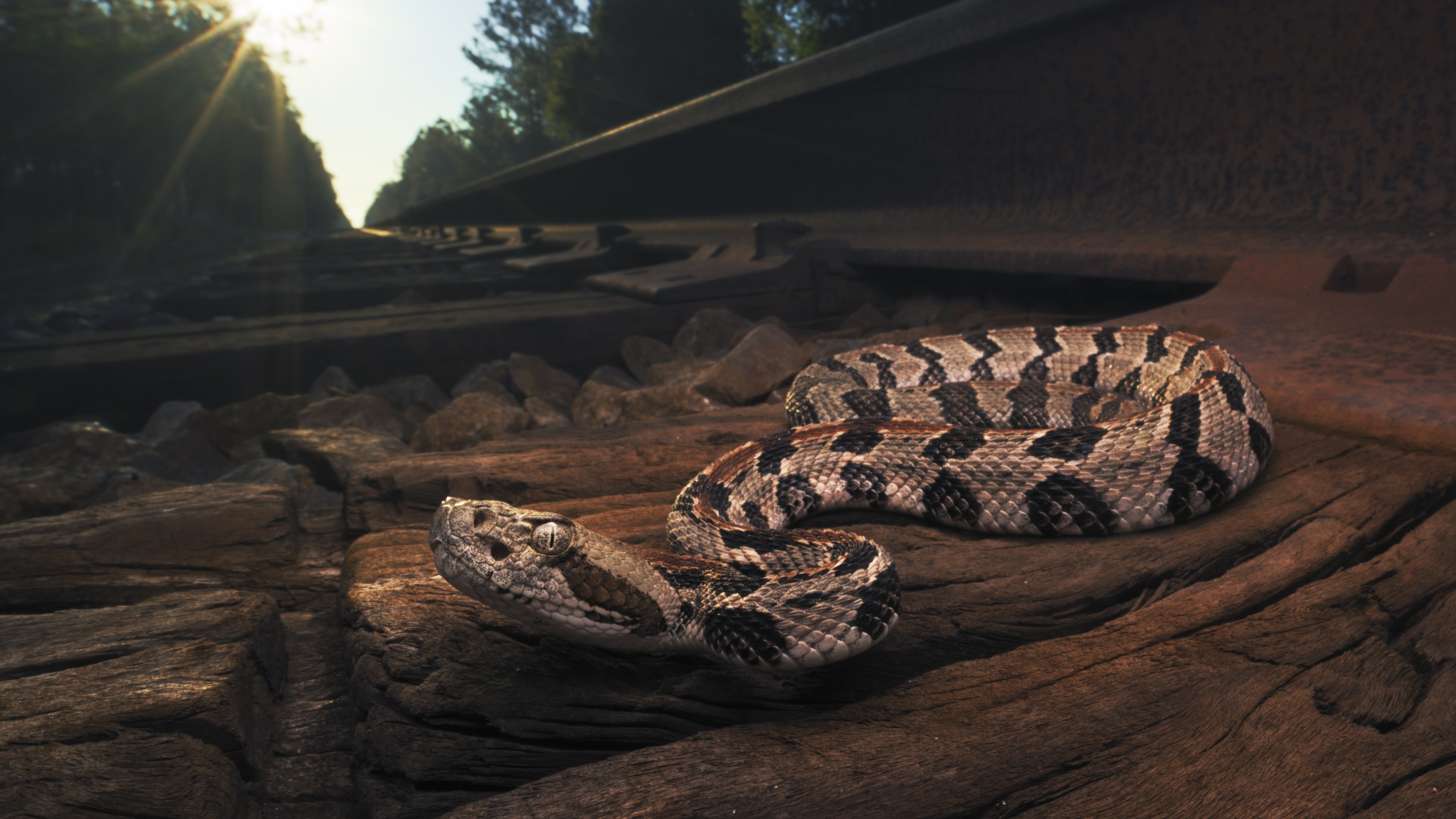Hiker picks up venomous snake, dies after bite triggers rare allergic reaction, authorities say
Authorities say a man died after being bitten by a venomous snake in Tennessee. The snake is believed to be a timber rattlesnake, which can have extremely potent venom, but the man likely died due to a rare allergic reaction.

A hiker recently died after being bitten by a rattlesnake in Tennessee and experiencing a rare allergic reaction to the snake's venom, reports indicate.
Emergency personnel were dispatched to a trailhead in the Savage Gulf State Park on Aug. 8. Medical workers gave the man CPR on the trail and transported him to a hospital, where he died. The man's identity has not been made public.
Witnesses said the hiker picked up the Rattlesnake, resulting in a bite to his hand, Matthew Griffith, director of the Grundy County Emergency Management Agency, told Live Science. The snake is believed to be a timber rattlesnake (Crotalus horridus), a species with potent venom but one that rarely bites humans unless provoked or stepped on.
"It is believed that the hiker had an allergic reaction however full details of actual cause of death have not been released," Griffith said in an email.
Venomous snake bites are rarely fatal in the U.S. Around 7,000 to 8,000 people are bitten by venomous snakes each year, and only about five of these result in a fatality, according to the Centers for Disease Control and Prevention (CDC). Most fatalities happen because of immediate anaphylactic reactions or because the person bitten doesn't seek medical attention.
Related: Cobra venom kills by collapsing blood vessels, organ-on-a-chip shows
Timber rattlesnakes are the largest and most dangerous venomous snakes in Tennessee, with heavy bodies that can grow up to about 5 feet (1.5 meters) long, according to the Tennessee Wildlife Resources Agency. The other venomous snakes in the state are pygmy rattlesnakes (Sistrurus miliarius), copperheads (Agkistrodon contortrix) and cottonmouths (Agkistrodon piscivorus).
Get the world’s most fascinating discoveries delivered straight to your inbox.
These snakes use their venom to hunt prey and for defence. Timber rattlesnakes normally eat small mammals such as squirrels and rats but will also occasionally hunt birds and reptiles. This species is an ambush predator, remaining still at the base of trees or beside fallen logs, waiting for prey to pass. Rattlesnakes can strike quickly from any position and do not always rattle before biting, according to the CDC.
Timber rattlesnakes aren't aggressive toward humans and avoid contact with people and pets if they can, according to the Florida Museum. If they do bite, there's also a small chance they won't inject their venom. This kind of strike is known as a dry bite and accounts for about 20% of all defensive rattlesnake bites, according to the Arizona-Sonora Desert Museum.
Snake venom is a complex mix of proteins that varies dramatically across different species and their populations. Rattlesnakes are vipers, which typically have haemotoxic venom that attacks the circulatory system. Haemotoxic venom causes bleeding and disrupts the blood's ability to clot, according to the Natural History Museum in London. However, rattlesnakes can also have neurotoxic venom, which attacks the nervous system. Timber rattlesnakes are known to have properties of both and can be equipped with extremely potent neurotoxic venom that lacks the hemorrhagic effects typical of rattlesnakes. Rattlesnake venom is also cytotoxic, which is destructive to tissue.
William Sutton, a professor at Tennessee State University who studies snakes, told The New York Times that a snake venom allergic reaction can be similar to a bee sting allergic reaction, with the potential to send someone into anaphylaxis, during which a person's airways narrow and their blood pressure lowers.
While rattlesnake bites aren't normally fatal with medical treatment, the venom can have long-term consequences. Around 10% to 44% of those bitten experience lasting injuries, such as losing part or all of their finger.
Griffith warned people engaging in outdoor activities to be mindful of venomous snakes and not to handle them.
"As always, it's strongly recommended to have some kind of first aid supplies while enjoying outdoor recreational activities and be mindful of wildlife and the dangers that some wildlife may pose," Griffith said. "If you encounter a snake simply remain calm and do not attempt to handle it. If bitten seek immediate medical attention."

Patrick Pester is the trending news writer at Live Science. His work has appeared on other science websites, such as BBC Science Focus and Scientific American. Patrick retrained as a journalist after spending his early career working in zoos and wildlife conservation. He was awarded the Master's Excellence Scholarship to study at Cardiff University where he completed a master's degree in international journalism. He also has a second master's degree in biodiversity, evolution and conservation in action from Middlesex University London. When he isn't writing news, Patrick investigates the sale of human remains.
You must confirm your public display name before commenting
Please logout and then login again, you will then be prompted to enter your display name.


